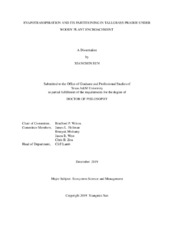| dc.description.abstract | Evapotranspiration (ET) drives the energy and mass exchanges between ground and atmosphere. Partitioning of ET into evaporation from both bare soil (E) and vegetation interception (I) and plant transpiration (T) is essential for quantifying water use efficiency and evaluating ecosystem functioning under climate change and land cover change. First, we carried out a worldwide meta-analysis on 31 in situ ET–partitioning studies reported in drylands. Over the long-term scale, E and T are roughly equivalent for most natural ecosystems, while T/ET is relatively higher for irrigated agroecosystems. Leaf area index is a significant variable than fractional cover to explain T/ET variations across dryland ecosystems. Secondly, a paired treatment-control configuration was set up in tallgrass prairie, with the treated denuded of vegetation, while the adjacent, control site kept undisturbed. Results showed that the incorporation of the soil heat storage (within 8 cm-depth) was indispensable for energy balance closure analysis. The yearly ET was 728 ± 3 mm and 547 ± 2 mm for the control and treated site, respectively. Thirdly, we applied a two-source isotopic mixing model to partition the ET flux. Two field campaigns were carried out to sample waters in various ecohydrologic pools during two wetting–drying episodes, with high antecedent soil moisture across the profile for Campaign 1, but soil moisture was only partially replenished in shallow layers prior to Campaign 2. We found that deuterium (^2H) is preferable to ^18O for Keeling-plot regression analysis. The mean ± standard deviation of T/ET was 0.80 ± 0.06 and 0.90 ± 0.06 during Campaign 1 and 2, respectively. When shallow soil moisture (especially within 10-cm depth) had been substantially depleted, the deep soil layer (up to 1 m) increasingly became the major source. Lastly, we investigated the effects of woody plants encroachment on the ET fluxes and isotopic processes. An intensive field campaign was carried out with rotatory isotopic sampling among tallgrass prairie grassland, oak woodland, and eastern redcedar woodland. The dual-isotope plots revealed that the trees had access to deeper soil moisture than grass did. During the peak growing season, ET and xylem water had similar isotopic composition across all these three ecosystems, indicating a convergent dominance of T in ET flux regardless of ecosystem types. | en |


